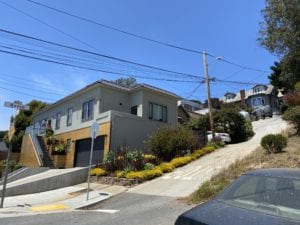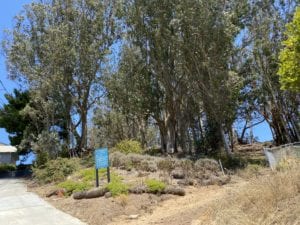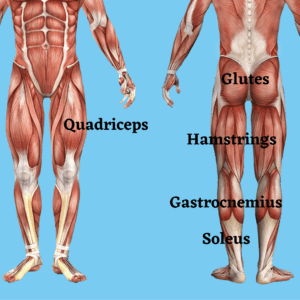
If you need a reason to be grateful to live in Glen Park during a pandemic, just think of all the opportunities you have to get in shape, or keep in shape, at absolutely no cost. Just put your mask on, go out your front door and walk up a hill, or climb one of the many staircases that make our neighborhood a fitness panacea.
As the video below by Joey Yee demonstrates, controversy abounds as to the steepest street in SF. (There’s so much at stake!)
Lo and behold, a nondescript one block stretch of Baden Street in Glen Park or Sunnyside, depending on which reference is used, has gotten a nod. According to Data Nerd Stephen von Worley, the block has a grade of thirty four percent, making it the fifth steepest in the city.
Rushing out to investigate, and no disrespect to the folks who live on this perfectly fine residential street, (although the adjoining Dorothy Erskine park cries out for TLC), there is no sense of revelation in arriving here and then mastering this very brief stretch of concrete. That is, until, in the name of research, one trudges up this one block of doom. The legs cry out for mercy.

For insight into the pain, let’s look into some light anatomy and physiology.
What muscles do we use to get up a hill?
Basically, all the muscles in your legs work to get you up and down hills and stairs at different times and in different stages.
The muscles used to climb hills and stairs are your
- anterior thigh muscles (quadriceps)
- posterior thigh muscles (hamstrings)
- butt muscles (glutes)
- calf muscles (gastrocs, soleus and tibialis posterior — this last one not pictured but functions to build our arches and raise our heels).

When you take a step up the hill, the leading leg pushes you up the hill using your quadriceps and glutes. While your leading leg works essentially to push you up, your back leg also drives you up by using your calf, quadriceps and glutes.
Which muscles engage and when depends on the size of the steps you take, how much you lean forward, and whether you land on your heel or toe with the leading leg. Landing on your heel engages your hams and glutes more, while landing on your toes engages your quads and calves more. Leaning forward more engages your glutes and hamstrings more and walking more upright engages your quadriceps more.
In terms of mechanics, the most efficient and easiest way to climb uphill is by leaning slightly forward and taking smaller steps. In this way, all the leg muscles work together, and the joints are less strained. That is also why, when climbing stairs, many small steps are easier to climb than fewer big steps.
If you are having trouble climbing hills or stairs, you may have weakness in some, if not all, of the muscles in your legs. You should be able to go from sit to stand more than ten times in thirty seconds and do at least ten single heel raises on each leg. If you are unable to do these exercises, you will have trouble with hills and stairs and would benefit from a professional evaluation.
Going downhill is a different story. The same muscles work differently – think of it as controlled muscle lengthening or controlled falling. These are “eccentric” contractions, which work better when done quickly in small steps.
If possible, leaning slightly forward and keeping your hips and knees slightly bent allows gravity to assist the descent and reduce the impact on your joints. Think of it as sitting down slightly as you descend.
The trick is finding that happy balance of letting gravity do most of the work while allowing your muscles to control the descent without braking too much. That’s why smaller quicker steps work better going downhill. Less braking, more controlled descent.
Adding hiking poles can help by bringing your arms in to help your legs. It widens your base of support to help your balance and adds your arm muscles to help your legs. They are useful if you are not strong, and/or your balance is not so good (which is key, especially when going down hills or stairs). Hiking poles are assistive devices, so the goal is to try to go without them, eventually.
In summary, all your leg muscles work to get you up and down hills and stairs. Which ones activate when are affected by the size of the steps, how far you lean into the step, whether you land on your heels or toes, and whether you are going up or down hill.
A San Franciscan can be spotted anywhere in the world because they always walk leaning forward!
Back to Baden Street: Again, no disrespect, this time to YouTube, but it just seems like in all of San Francisco there must be steeper inclines which would snag fifth place in a contest. No matter about this officially unconfirmed video. The point is, get out and walk, climb, and challenge those hams, quads, and glutes. You need go no further than a few blocks to find vertical nirvana in Glen Park.
Dr. Kylie E. Rowe PT is a local physical therapist, owner of Living Healthy Physical Therapy.